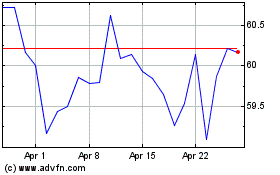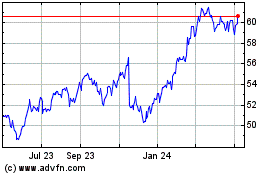NEW DELHI–Amazon.com Inc. founder Jeff Bezos, perturbed by his
company's failure to capture much of the massive Chinese market,
had a pointed message for executives in India during a visit in
2014: Don't let that happen here.
Do what it takes to succeed and don't worry about the cost, Mr.
Bezos said, according to a person who was present.
Amazon, which dominates online selling in the U.S. but so far
has gained little traction in developing countries, has since
invested billions of dollars to build a logistics network spanning
India to reel in shoppers.
The result: the company rapidly became India's No. 2 e-commerce
player and moved within striking distance of local rival Flipkart
Internet Pvt., according to some estimates. Indeed, Mr. Bezos last
month declared Amazon was on top in a market it largely had ignored
until recent years, though he didn't say by which measure.
"We are winning in India," Mr. Bezos said at a conference in San
Francisco, arguing that Amazon has pulled past Flipkart to become
"the leader in India now."
Amazon's attempts to push into developing markets—marked by
difficult logistics and significant cultural differences in
shoppers' expectations—reflect the e-commerce giant's search for
new routes to growth as it saturates the U.S. market. Countries
such as China and India promise rapidly growing populations with
steep rates of online shopping adoption as technology becomes more
accessible.
India is a potential driver of profitability and growth for the
company's international segment, which has lagged behind Amazon's
domestic operations. International sales comprised about a third of
Amazon's $107 billion in sales last year.
The company's progress in the South Asian nation so far is in
contrast to its trajectory in China, where it is a distant also-ran
to domestic players in the world's largest online-selling market,
worth $899 billion. Amazon as of last year had just a 1.3% share of
the total business-to-consumer market in China, according to a
Daiwa Capital Markets report, citing data from iResearch.
This year's biggest Indian holiday-shopping season—Diwali, the
Hindu festival of lights that began last month—could be a critical
test as the company moves from catching up to taking over in the
world's second-most populous country.
"This is probably an inflection point," said Amit Agarwal,
Amazon's India head. "We have been investing very
aggressively."
Amazon had missed the party in China by picking the wrong pace
and partners as e-commerce took off. In India it decided to invest
more even though the overall market was still small.
Amazon's experience in China taught the company the importance
of "investing aggressively right from the beginning and having a
very long-term orientation," Mr. Agarwal said.
India's e-commerce companies don't share their sales numbers,
but analysts agree the results of Amazon's blitzkrieg are
significant.
Bank of America Merrill Lynch estimates that by the end of this
year Amazon will control about 28% of India's total e-commerce
gross merchandise volume. That is still well behind market leader
Flipkart's 43% share. But if you take away the sales of Flipkart's
separate fashion website, Amazon's sales have been higher in recent
months, says a report by Bank of America Merrill Lynch's Sachin
Salgaonkar.
"We see potential for Amazon to emerge as the number one
e-commerce platform in India," Mr. Salgaonkar wrote.
India, with a population of more than 1.2 billion, only has
about 40 million online shoppers, according to Credit Suisse.
India also faces a severe gender gap when it comes to web
access. Only about 30% of internet users are female, according to
estimates by the Internet and Mobile Association of India.
Meanwhile, Amazon isn't the only one with deep pockets. Chief
U.S. rival Wal-Mart Stores Inc. is in talks to invest in
Flipkart.
Still, if Amazon's wager on India works out the country could
become a pillar of the company's growth for years. While e-commerce
sales in India remain relatively tiny, at about $11 billion, they
are likely to grow 10 fold in a decade, Goldman Sachs
estimates.
In 2014, Mr. Bezos stepped off a colorfully painted Indian truck
in Bangalore in a white Nehru jacket to hand over a surfboard-sized
$2 billion novelty check to Mr. Agarwal to expand Amazon's India
operations. "We see huge potential in the Indian economy," Mr.
Bezos said at a news conference.
Amazon has been bringing to bear its trademark weapons, such as
a powerful search engine that can guess what customers are looking
for and what they might buy next, and high-tech warehouse
facilities that speed deliveries and cut costs. It also turned to
new tactics to suit the Indian market, such as deploying swarms of
motorcycle delivery men with huge backpacks and accepting cash on
delivery for customers without credit cards.
Amazon has wooed hundreds of thousands of Indian small-business
owners such as Bhavin Jagani, who runs a small kitchen-wares
business in Mumbai. Amazon representatives taught him how to take
products that weren't panning out on Amazon's competitors' websites
and photograph and describe them in a way that would attract more
customers on Amazon's intelligent search engine. "From losing money
on other sites, I've started making money on Amazon," he said.
Amazon now has more than 80 million products on its India
website. And Mr. Bezos has since doubled down on his India bet,
pledging another $3 billion in investment in June.
Karan Deep Singh in New Delhi and Laura Stevens in San Francisco
contributed to this article.
(END) Dow Jones Newswires
November 17, 2016 07:55 ET (12:55 GMT)
Copyright (c) 2016 Dow Jones & Company, Inc.
Walmart (NYSE:WMT)
Historical Stock Chart
From Mar 2024 to Apr 2024

Walmart (NYSE:WMT)
Historical Stock Chart
From Apr 2023 to Apr 2024
